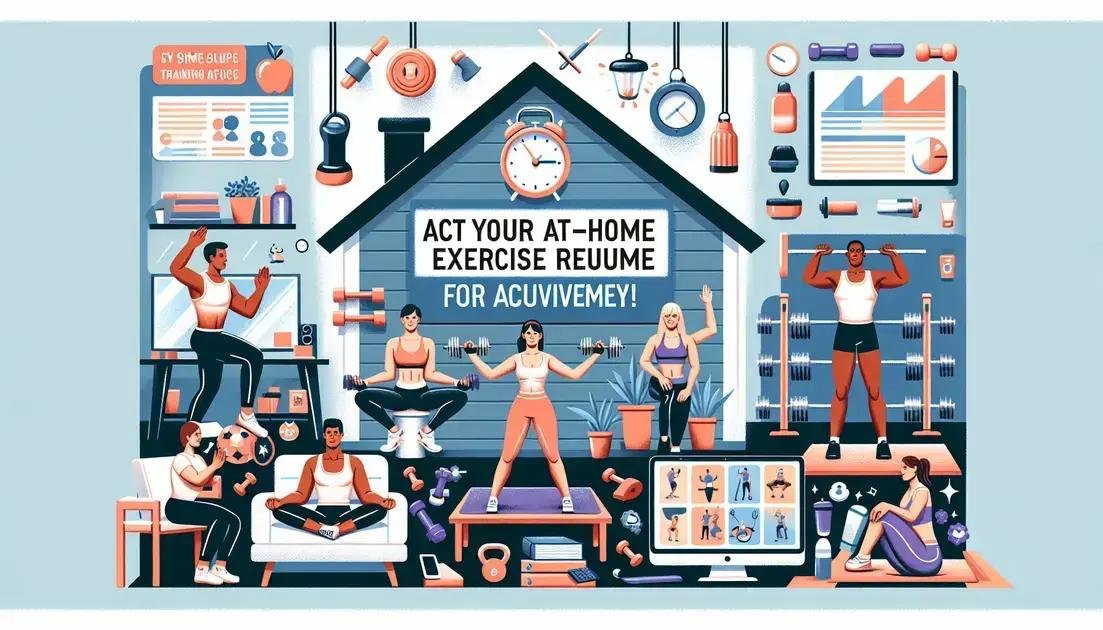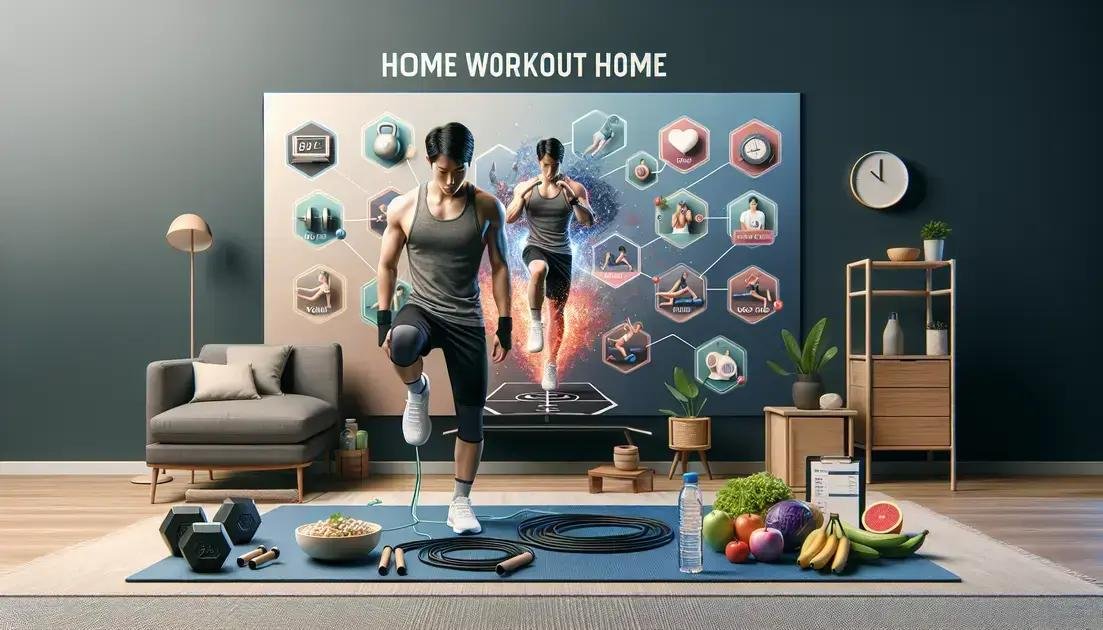
“Kickstart Your Home Workout Routine for Success!”
-
Lucas Souza
-
8, janeiro, 2025
Topics
 Shared
Shared
Starting a home workout routine can be both exciting and challenging.
With the right approach, you can achieve your fitness goals while working out from the comfort of your home.
Understanding how to begin, set goals, and stay motivated is crucial.
This guide will help you create a successful routine that fits your lifestyle, using effective strategies and tools available today.
Setting Clear Fitness Goals
Setting Clear Fitness Goals
To embark on a successful home workout routine, it is vital to set clear and achievable fitness goals. Start by determining what you want to accomplish. Is it weight loss, muscle gain, increased flexibility, or overall health improvement? Define your goals using the SMART criteria: Specific, Measurable, Achievable, Relevant, and Time-bound. For example, instead of saying ‘I want to get fit,’ state ‘I want to lose 10 pounds in three months by exercising four times a week.’ This precision will keep you focused and motivated as you track your progress.
Choosing the Right Workout Space
Your workout environment can significantly impact your motivation and performance. Select a dedicated space in your home where you will exercise consistently. Ensure it is clean, well-lit, and free from distractions. A living room corner, garage, or even a spare room can work. Personalize your space with motivational quotes or pictures to inspire you during workouts.
Essential Equipment for Home Workouts
You don’t need a lot of expensive gear to work out at home. Start with a few essential items. Dumbbells, a mat, and resistance bands are versatile and can support various exercises. As you progress, consider adding a kettlebell or a stability ball. The key is to have equipment that suits your fitness level and workout preferences.
Creating a Balanced Workout Schedule
A well-structured workout plan is crucial for success. Divide your workouts into various categories: strength training, cardio, and flexibility. Aim for at least 150 minutes of moderate-intensity exercise weekly. For example, allocate three days for strength training, two days for cardio, and one day for yoga or stretching. Consistency is the foundation of progress.
Incorporating Warm-Up and Cool-Down Routines
Start every workout with a warm-up to prepare your body and reduce injury risk. Spend 5-10 minutes engaging in dynamic stretches or light aerobic exercises. After your workout, always cool down with stretches to help your muscles recover. This practice enhances flexibility and relieves tightness, allowing for better performance in future workouts.
Exploring Different Exercise Types
Diversity in your workout routine keeps it interesting and targets various muscle groups. Explore activities such as high-intensity interval training (HIIT), yoga, or dancing. Experiment with classes or online tutorials to find what you enjoy most. Engaging in different exercises helps prevent boredom and maintains motivation.
Staying Motivated at Home
Motivation can wane when exercising at home. To keep it high, establish a consistent schedule, treat workouts like appointments, and track your progress in a journal or an app. Surround yourself with supportive friends or join online communities where you can share experiences and tips. Celebrate small achievements to maintain enthusiasm.
Tracking Your Progress
Monitoring your advancement is critical for staying on course. Utilize a fitness journal or apps to record your routines, weights used, and how you feel after each session. Regularly assess your results, such as body measurements or strength milestones, to see how far you’ve come. This reflection will help adjust your goals and maintain motivation.
Adjusting Your Routine Over Time
As you grow stronger or lose weight, your workout must evolve. Regularly assess your routine and make changes based on your progress or changing goals. Incorporate new exercises, increase weights, or vary workout lengths for ongoing challenges. This adaptation prevents stagnation and enhances fitness gains.
Nutrition Tips to Complement Workouts
Good nutrition plays a crucial role in supporting your fitness journey. Focus on a balanced diet rich in whole foods like lean proteins, fruits, vegetables, whole grains, and healthy fats. Stay hydrated and consider meal prepping to stay on track. Understanding what fuels your body will enhance your workout performance and recovery.
Avoiding Common Home Workout Mistakes
When working out at home, it’s easy to fall into common pitfalls. Ensure you maintain proper form to avoid injury, and don’t skip warm-ups and cool-downs. Set realistic expectations for your progress, as fitness takes time. Also, be mindful of distractions; turn off your phone notifications to maintain focus during workouts.
Using Apps and Online Resources
Take advantage of technology to enhance your home workout. Numerous apps can guide you in planning routines, tracking progress, and providing video demonstrations. Platforms like YouTube offer plenty of free workout videos across various fitness levels and styles. Leverage these resources for support and motivation as you navigate your fitness journey.
Choosing the Right Workout Space

Choosing the Right Workout Space
Finding the perfect workout space in your home can boost your motivation and performance. Choose an area with ample room to move freely and safely.
Make sure it has good lighting and is well-ventilated to keep you comfortable. If possible, find a location away from distractions, like televisions or busy living areas.
Declutter the space and keep your workout gear easily accessible, so everything you need is within reach. It can be a corner of your living room, a garage, or even a dedicated room.
Personalize it with motivational posters or have your favorite music ready to create an energizing atmosphere.
Essential Equipment for Home Workouts
Essential Equipment for Home Workouts
When starting a home workout routine, it’s important to have the right equipment that matches your fitness goals. You don’t need to invest in expensive machines; a few key items can get you started and help you progress. Begin with dumbbells, which are versatile and allow you to perform various exercises targeting different muscle groups. A yoga mat is essential for floor workouts, providing comfort and support during stretches and strength training.
Resistance bands can add extra challenge to bodyweight exercises and are great for building strength. If you enjoy cardio, consider a jump rope or an exercise ball, which can be used for core workouts and balance training. Finally, comfortable workout clothes and a good pair of sneakers are crucial for safety and performance.
As you progress, you may want to expand your equipment collection, but starting with these essentials will set a solid foundation for your fitness journey. Remember, the best equipment is what inspires you to get moving!
Creating a Balanced Workout Schedule

Creating a Balanced Workout Schedule
Developing a balanced workout schedule is key to achieving your fitness goals. Start by determining how many days a week you can commit to exercising. Aim for at least three to five days each week. A balanced schedule should include a mix of strength training, cardio, and flexibility exercises.
For example, you could dedicate Monday and Thursday to strength training, focusing on different muscle groups each day, like upper body one day and lower body the next. Reserve Tuesday and Saturday for cardio workouts, such as running, cycling, or HIIT (high-intensity interval training). Finally, include flexibility workouts like yoga or stretching on Wednesday and Sunday. This routine not only promotes overall fitness but also helps prevent injuries and avoids overtraining.
Make sure to listen to your body and adjust the intensity and duration of workouts as needed. Keeping a calendar or using an app to plan your workouts can also keep you accountable and on track. By maintaining a balanced approach, you’ll enhance your fitness journey over time.
Incorporating Warm-Up and Cool-Down Routines
Incorporating Warm-Up and Cool-Down Routines
Including warm-up and cool-down routines in your home workout is essential for preventing injuries and promoting recovery. A warm-up prepares your body for exercise by gradually increasing your heart rate and loosening your muscles. Start with 5 to 10 minutes of light aerobic activity, such as jogging in place or jumping jacks, to get your blood flowing.
Follow this with dynamic stretches that focus on the muscles you’ll be using during your workout. For example, perform arm circles, leg swings, or torso twists. These movements enhance flexibility and help to prevent strains.
After completing your workout, a proper cool-down is equally important. Spend another 5 to 10 minutes reducing your heart rate by walking around slowly. Then, incorporate static stretches targeting the major muscle groups you worked. Hold each stretch for 15 to 30 seconds to promote muscle relaxation and prevent stiffness. This practice helps your body transition back to rest and recover effectively.
Exploring Different Exercise Types

Exploring Different Exercise Types
To keep your home workout routine fresh and exciting, it is essential to explore various types of exercises. Incorporating different styles targets multiple muscle groups and prevents boredom. Start with cardiovascular exercises, such as running, cycling, or jumping rope. These activities improve your heart health and burn calories.
Strength training is equally important for building muscle and enhancing metabolism. You can use weights, resistance bands, or your own body weight to perform exercises like push-ups, squats, and lunges. Aim to target different muscle groups on different days to ensure balanced development.
You should also consider flexibility and mobility exercises such as yoga or Pilates. These practices improve flexibility, balance, and endurance, which can enhance your performance in other workouts. Incorporating core workouts is also vital; strong core muscles enhance stability and support overall strength.
Variety is key to sustaining motivation and achieving fitness goals. Take time to experiment with classes online or apps. This way, you can discover new activities and find what you enjoy most!
Staying Motivated at Home
Staying Motivated at Home
Maintaining motivation while working out at home can be challenging. To keep your spirits high, establish a set workout schedule and treat it like an important appointment. Consistency helps form habits. Consider working out at the same time each day to build a routine.
Another effective method is to set small, achievable goals. Celebrate milestones, whether it’s completing a certain number of workouts or mastering a new exercise. Keeping a workout journal can help you track your progress, which serves as a visual reminder of your improvements.
Incorporate variety into your workouts by trying different styles, such as HIIT, yoga, or dancing. This change not only keeps things interesting but also challenges your body in new ways. Additionally, join online fitness classes or communities to interact with others who share your goals. Social connections provide accountability and encouragement.
Lastly, reward yourself for sticking to your routine. Whether it’s a new workout outfit, a massage, or a favorite healthy snack, these incentives can motivate you to keep going. Remember, discovering what brings you joy in fitness is key to long-term success.
Tracking Your Progress
![]()
Tracking Your Progress
Monitoring your progress is vital for staying on track with your home workout goals. Start by setting specific metrics to evaluate, such as your weight, body measurements, or fitness levels. Use a fitness journal to record your workouts, including the exercises performed, repetitions, weights used, and how you felt during each session.
Another helpful method is to utilize fitness apps or wearable devices that track your activities and provide insights into your performance. Many apps offer features like goal setting, workout reminders, and progress graphs, making it easier to see improvements over time.
Regularly assess your progress every few weeks to determine if you are moving closer to your goals. This could include re-evaluating your measurements or even doing fitness tests, such as timed runs or max repetitions of an exercise. This reflection will help you recognize your accomplishments and adjust your routine as needed to stay motivated.
Finally, celebrate your achievements, no matter how small. Recognizing your hard work fosters a positive mindset and keeps you committed to your fitness journey.
Adjusting Your Routine Over Time
Adjusting Your Routine Over Time
As you progress in your fitness journey, it’s important to adjust your workout routine to continue seeing results. Begin by evaluating your current progress every few weeks. Look at how your strength, endurance, and flexibility have improved. This assessment will help you determine if your routine needs changes.
If you find that your current workouts are no longer challenging, consider increasing the intensity. You can do this by adding more weight, increasing repetitions, or incorporating more complex exercises. For example, if you’re comfortable with a particular weight, try adding 5-10% more to push yourself further.
Also, make sure to change up your exercises regularly. If you’ve been doing the same workout for a while, your body can adapt, leading to a plateau. Introduce new exercises or different training styles such as circuit training, plyometrics, or yoga to stimulate new muscle growth.
Be mindful of your overall fitness goals and adjust accordingly. If your goal changes, such as moving from weight loss to muscle building, tailor your routine to support that shift. Staying flexible in your approach will keep your fitness journey engaging and rewarding.
Nutrition Tips to Complement Workouts

Nutrition Tips to Complement Workouts
Proper nutrition plays a crucial role in maximizing your workout results. Focus on maintaining a balanced diet that includes a mix of carbohydrates, proteins, and healthy fats. Carbohydrates provide the energy you need for workouts, while protein is essential for muscle repair and growth. Aim to eat a variety of whole foods, including fruits, vegetables, whole grains, lean meats, and legumes.
Timing your meals is also important. Try to eat a small meal or snack about 30 to 60 minutes before your workout. This meal should be rich in carbohydrates and moderate in protein, such as a banana with peanut butter or a smoothie with fruit and yogurt. Post-workout, consume a meal with both protein and carbohydrates to aid recovery, like grilled chicken with quinoa and vegetables.
Staying hydrated is another key factor. Drink water before, during, and after exercise to keep your body functioning optimally. If you engage in long, intense workouts, consider replenishing electrolytes with an electrolyte drink or coconut water.
Finally, don’t forget to listen to your body. Pay attention to how different foods affect your performance and recovery, and adjust your diet accordingly. Keeping a food journal can be helpful in identifying what works best for you.
Avoiding Common Home Workout Mistakes
Avoiding Common Home Workout Mistakes
When exercising at home, it’s easy to make mistakes that can hinder your progress or lead to injury. One common mistake is skipping the warm-up. Always take time to warm up before your workout to prepare your body and reduce injury risk. This should include light cardio and dynamic stretches.
Another mistake is neglecting form. Proper technique is crucial for safety and effectiveness. If you’re unsure, consider watching instructional videos or using a mirror to check your posture during exercises. Avoid rushing through workouts, as this can lead to poor form and increase the risk of injury.
Also, be mindful of setting unrealistic goals. While it’s great to aim high, setting goals that are too ambitious can lead to frustration. Instead, set small, achievable goals that allow for gradual progress.
Finally, don’t forget to listen to your body. If you feel pain or extreme fatigue, take a break. Pushing through discomfort can lead to injuries that will set you back. By avoiding these common mistakes, you can ensure a safer and more effective home workout experience.
Using Apps and Online Resources

Using Apps and Online Resources
In today’s digital age, leveraging apps and online resources can greatly enhance your home workout experience. Numerous fitness apps offer guided workouts, tracking features, and reminders to keep you accountable. Popular options include MyFitnessPal for tracking nutrition and meals, and Fitness Blender for access to free workout videos across various fitness levels.
Online platforms like YouTube have countless channels dedicated to workouts, providing everything from yoga to high-intensity training. These resources allow you to explore different styles and find what you enjoy most, keeping your routine fresh and exciting.
Consider joining online fitness communities or social media groups focused on health and fitness. These groups offer support, motivation, and shared experiences from others on similar journeys. You can exchange tips and challenges, making your workout experience more social and engaging.
Finally, many gyms offer virtual classes that you can access from home. Take advantage of these offerings to stay connected with trainers and fitness classes. Utilizing these apps and online resources will give you the tools and motivation to stick to your home workout routine.
Conclusion
Creating a successful home workout routine requires careful planning and commitment. By setting clear fitness goals, choosing the right space, and utilizing appropriate equipment, you can foster a productive environment for exercise.
Incorporating a balanced workout schedule, warm-up and cool-down routines, and exploring various exercise types will enhance your fitness journey.
Moreover, staying motivated, tracking progress, and adjusting your routine as needed are essential strategies to maintain enthusiasm and achieve desired results. Don’t forget the importance of nutrition to fuel your workouts, and always strive to avoid common mistakes.
With the help of apps and online resources, you can further enrich your home workout experience. Embrace this journey, and remember that consistency and adaptability are key to finding lasting success in your fitness endeavors.
FAQ – Home Fitness and Wellness
What are some effective fitness goals I can set?
Effective fitness goals should be SMART: Specific, Measurable, Achievable, Relevant, and Time-bound. Examples include losing 10 pounds in three months or exercising four times a week.
How do I choose the best workout space at home?
Select a clean, well-lit area with enough room to move freely, away from distractions. Personalize it to enhance motivation.
What equipment do I need to start working out at home?
Basic equipment includes dumbbells, a yoga mat, resistance bands, and comfortable workout clothes. Start with essentials to build your routine.
How can I create a balanced workout schedule?
Allocate days for different exercise types: strength training, cardio, and flexibility. Aiming for 150 minutes of moderate exercise weekly is recommended.
Why are warm-up and cool-down routines necessary?
Warm-ups prepare your body for exercise and reduce injury risk, while cool-downs help your body recover and improve flexibility.
What types of exercises should I include in my routine?
Include a mix of cardiovascular exercises, strength training, flexibility workouts like yoga, and core workouts to improve overall fitness.
How can I stay motivated while working out at home?
Establish a routine, set achievable goals, vary your exercises, and join online fitness communities for support and encouragement.
What is the best way to track my workout progress?
Keep a fitness journal or use apps to log exercises, track progress, and set new goals regularly.
How often should I adjust my workout routine?
Reassess your routine every few weeks. Adjust intensity, exercises, or goals to continue progressing and prevent plateaus.
What should I eat before and after workouts?
Eat a small snack rich in carbohydrates and moderate in protein before workouts. Post-workout, enjoy a meal combining protein and carbs for recovery.
What are some common mistakes to avoid when working out at home?
Avoid skipping warm-ups, poor form, setting unrealistic goals, and not listening to your body. Consistency and awareness are key.
How can apps and online resources help my fitness journey?
Fitness apps can provide guided workouts, track your progress, and remind you to stay active. Online platforms offer video tutorials and community support.
 Return blog
Return blog